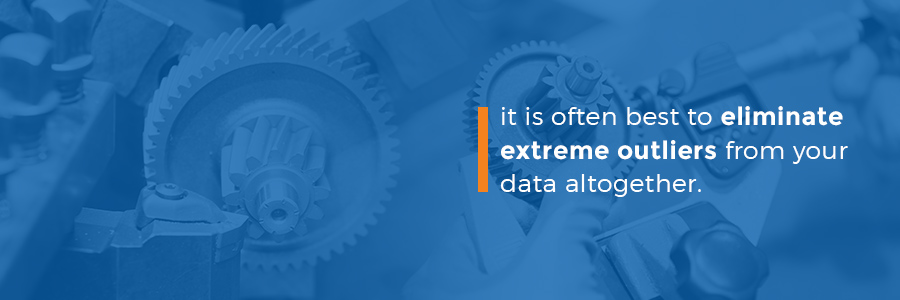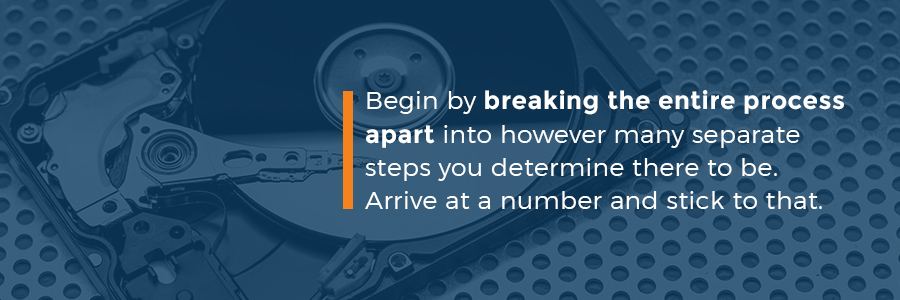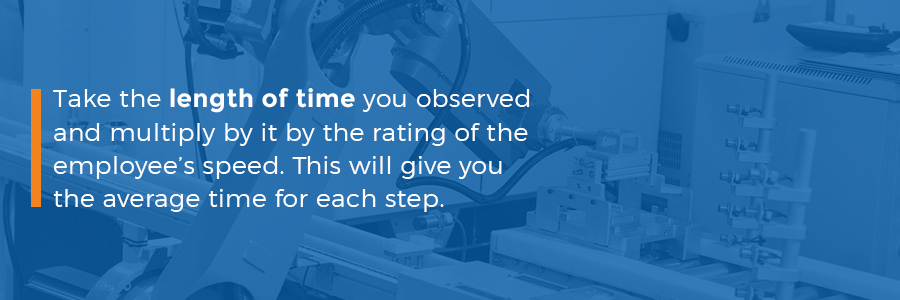If you work in a manufacturing business of any kind, your company’s job is to make sure everything job gets done as quickly and efficiently as possible. But is there really a way to measure something like that? Can you truly determine the best way to do something, and if so, how?
As it turns out, there are indeed ways to quantify production methods to determine which is the best. One of the best ways to find the fastest and most efficient production method is through performing time and motion studies.

Never heard of a time study? It’s quite simple and is very much like what the name suggests. A time study in manufacturing essentially examines every step in your manufacturing process and determines how long they all take on an average basis. Then, through careful examining of each step in the process and how long they take, it is possible to determine where the most significant amounts of time are lost and how these time periods can be improved, shortened and made more efficient.
Another type of study you can do either in tandem with a time study or as its own separate entity is a motion study. A motion study follows the same basic concept, but it applies to motions instead of time. Workers’ exact movements during the manufacturing process are recorded and then analyzed so companies can determine which actions are inefficient and can be improved.
The idea of these types of process observation in manufacturing is that by analyzing the finer details of the manufacturing process, they can reach the most perfect and efficient possible method — thus streamlining the process to become as ideal as possible.
Work Sampling vs. Time Studies
If you know a bit about time studies, you may have also heard the term “work sampling.” Instead of being a completely separate process with its own unique agenda, work sampling is a tool that exists to further the goals of time studies and help them along their way.
Work sampling refers to the process where you periodically examine samples of the product throughout the manufacturing process. By inspecting samples from various stages throughout the workers’ progress, you are learning how long the process takes to advance to a particular step in manufacturing.

If a time study is the process of determining the most efficient amount of time to spend on a particular phase of the manufacturing process, then work sampling is one of the most effective tools to help this process along. By looking at critical samples of work, your company will be able to determine how long it took to produce this product, as well as how they might be able to shorten that amount of time for maximum efficiency.
To be most effective and helpful, it usually isn’t enough to take just one work sample. You’ll need to take many work samples, on different days, in different circumstances and from different workstations. By comparing all these various work samples, you and your company will eventually begin to form a picture of the average stage of development for the product at a particular time mark. You will start to see where the delays are, and where you can implement corrections and improvements.
How to Prep for a Time Study
Thinking you want to perform a time study? This is a decision that will benefit you and your company immensely moving forward. However, it isn’t a process you can jump into with no practice or preparation. You will need to use precise methods, and if you don’t take the time to learn them, the whole process might be for nothing.
To ensure your time study delivers the most significant results possible, here are seven tips and instructions for prepping for a time study of your own.
1. Develop a Strong Rationale for Conducting the Study
Why do you want to do a time study? The answer might be obvious to you, or it might not. Most time studies are conducted merely to learn how long things take, but there can be other reasons, as well. Maybe you feel performance is lacking and are looking for ways to speed it up. Or perhaps you’re simply looking for a rubric so you can reasonably evaluate your employees’ performances.

Whatever your reasons are for conducting this study, its best to firmly establish them for yourself before you begin. If you’re feeling a little unsure about your motivations, consider putting them down in writing. If any employees express concerns about the study, you will be ready and equipped with a satisfactory answer for them.
2. Choose What You Want to Measure
To keep your study manageable, it might not be realistic to measure every single aspect of work and manufacturing that happens under your roof. Instead, set boundaries and practical limits for your study. Decide how you will handle things like worker breaks. Choose how many variables you want to incorporate into your research.
If you’re not confident of how to handle all the different factors, consider asking your employees questions that might help you. Ask them:
- Where they think they spend most of the day
- What part of their work is the most time consuming
- How long they think it takes
Ask multiple employees these questions, and compare their answers. You might be surprised at the responses you get, and you also might find the inspiration you need to decide which direction to take your project.
3. Decide How Detailed You Want to Be
A time study can be as complicated or as simple as you want it to be. You can express any step in the manufacturing process simply or not, and it’s up to you to decide how to quantify this. Do you want to measure data on each tiny individual sub-set of time, or do you only want to measure the larger blocks as whole units?

Realize the more you choose to break the units of time down, the more complex and challenging your study will be, but the higher its potential for improving your operations grows. On the other hand, a simple study will be much easier, but it may not be quite as helpful or insightful.
4. Designate a Representative Time Period to Study
It’s important that your time study takes place during a period that accurately represents your company’s typical work environment. For example, don’t perform your study while half the employees are on vacation, your floor is being repainted or you’re being evaluated by the higher-ups. Instead, choose a regular period when everything is operating as usual, and your employees are performing at their normal capacity.
The risk of performing your study during an irregular period is that the data you collect will not accurately represent your operation. Thus, any conclusions you arrive at based on this data will be inherently flawed and almost if not entirely useless.
5. Consider Ignoring the First Several Days of Results
In many cases, it may be wise to simply ignore all the results collected from the first few days of your study. This may initially sound incredibly counter-intuitive, but consider it this way. Many of your employees may be nervous and on-edge about being recorded and studied. As a result of these nerves, their performances may be fluctuating wildly far off the mark of their ordinary work. As such, data collected during these days is unlikely to be representative.

After a day or two, your employees will probably shake off the worst of their nervousness and work will mostly return to normal. Once this happens, you can begin recording results.
6. Use Responsible Sampling Procedures
For your data to be accurate and representative, you must follow best practices for collecting work samples. Firstly, you’ll need to be aware of your sample size. Because you’ll need to allow for a margin of error on both ends of your data, you should collect a large enough sample size that this will not matter very much.
Secondly, the samples must be truly random. If you are always taking your samples from the same worker, this data will not be representative of your entire operations. Similarly, if you’re only choosing the best or worst worker, this is not random and will not yield helpful and informative data.
7. Review Your Basic Understanding of Data Trends
If you’re going to complete a statistical study, it’s best to make sure you have a solid understanding of data trends and the primary measures of central dependency. Review such basic terms and concepts as:
- Outliers: These are data points that are far higher or far lower than almost every other one you have collected. It is fair to assume that something unusual happening to produce these numbers and that they are not representative of the data as a whole. So as not to skew your calculations, it is often best to eliminate extreme outliers from your data altogether.

- Average: Also known as the mean, this number refers to the figure that is the best representative of all the collective data. Add each data point together, then dividing by the total number of points to reach this figure.
- Median: This value represents the exact midpoint of all the data points collected. Exactly half your data points will be lower than the median, and half will be higher.
- Mode: Representing the most frequently occurring value or data point, the mode can help you determine trends and commonalities within your manufacturing process.
- Spread: This refers to the overall shape of the distribution of data points. If the points are all clumped together, it shows little variability and will create a tall, narrow shape. On the other hand, points that are vastly spread-out display an enormous variety of data points and will create a low-lying, spread-out shape.
How to Do a Time Study: A Step-by-Step Guide
Once you feel you have a firm grasp of what you want your study to consist of and how complicated you want it to be, as well as how you plan to interpret the data afterward, then you’re ready to begin the study.
To get started, follow these five steps.
1. Observe the Manufacturing Process
Your study begins by simply observing the process in front of you. Watch what the workers are doing. Observe how the product takes shape, how the workers move from one step to the next and how all the various parts fit together to create the manufacturing process as a whole. Keep watching until you feel you have a firm grasp of how the product progresses.
2. Decide on a Fixed Beginning and Ending Point
This is crucial to the success of your study. To be able to gather useful data, you will need to determine the exact points at which the assembly begins and ends. This cannot be a generic step — it must be a precise moment at which you decide the product is complete and the timer will stop. It’s important to leave no room for ambiguity here. For example, is the product finished when the worker attaches the last piece? Or is it finished when someone places the finished product in its proper packaging? Maybe it isn’t done until a worker puts it back down on the assembly line.

This might seem like nit-picking, but it’s of the utmost importance to clarify this point. If you leave it open, your data will vary wildly and your results will be inaccurate. Consider the difference between stopping the timer when the last piece is attached versus when the product is fully packaged. It could be enough to skew all your data.
3. Break the Manufacturing Process Into Steps and Determine Their Beginning and End Points
Now that you’ve determined an overall beginning and end point for the assembly process as a whole, it’s time to repeat this step until you have the entire process cataloged and accounted for.

Begin by breaking the entire process apart into however many separate steps you determine there to be. Remember, you can be as surface-level or as in-depth as you want. Maybe you decide the process only has five steps, or maybe you think it has 25. Whatever you choose, arrive at a number and stick to that.
Your next step will be to determine the exact fixed endpoints and starting points of each step. To do this, use the method we discussed earlier. Remember, the importance of these fixed bookend points is that it will help give your data clarity and reliability later on. Failing to establish these firm bookends means your data will be wobbly and insubstantial.
Write all of this down on whatever paper, spreadsheet or template you’re using to record your data. Now, it’s time to gather your recording tools, pen and stopwatch and get ready to collect some data.
4. Record Your Data
When the assembly reaches the starting point you’ve decided on, start your stopwatch. Pause the stopwatch when the assembly reaches the endpoint you decided on. Record the times again and again and again, until you’ve collected as large a sample size as you intended. Do this for all the steps you have listed, until you have a vast pool of sample times for every step recorded.
As you are recording times, be sure to also take note of the rating of each step of the assembly. This refers to whether or not the employee is working at their average speed, or if they’re going slower or faster than usual. For example, a 100 percent rating would refer to an employee working regularly, while 110 percent would be an employee working faster than usual.
5. Analyze Your Data
Now that you have recorded all the times, it’s time to analyze them and do a little math to arrive at a determination of the average time for each step.

To do this, take the length of time you observed and multiply by it by the rating of the employee’s speed. This will give you the average time for each step. From here, add the value of the average times of each step together to arrive at the average time for the entire assembly. In a different column of your calculations, sum up your base observed time, without the additional count of employee rating.
Divide the total average time — the calculation that includes the employee rating — by the entire base observed time total. As a separate calculation, divide the total average time by the number of cycles you observed. This total will be the average normal time. The final step is to factor in the number of allowances and breaks taken by employees.
The final tally should represent the average amount of time it takes for assembly to be completed.
Should You Perform a Time Study?
Because we’ve spent this time discussing the correct way to perform a time study and all the considerations that go into completing one correctly, it seems worthwhile to ask the question: should your company do one in the first place? Do studies such as this still have a place in the modern manufacturing industries? We think they do.
It’s worth noting that any study of this type will have a degree of inaccuracy to it, simply because workers behave differently when they know they are under observation. Even if the study determines changes need to be made and these changes lead to improvement, it is not certain what the exact cause of the growth was. Research has shown that workers’ performances tend to improve after any change, regardless of whether or not the change itself is the root source of the improvement.

Does this mean the study is pointless? Absolutely not. Time and motion studies have the potential to inspire significant improvements in your workplace, and they’re very much worthwhile to perform. They are great tools to identify places where workers are wasting time and energy that could be better directed to make your workplace more efficient and timely.
It is essential to be aware, however, that no study is perfect. No matter how careful you are when conducting your study, there will be gaps, inaccuracies and unanswered questions. Maybe your study will produce the results you want, or perhaps not. It is always worth it to make an effort to improve your company’s performance, however, and time studies are a great way to seek out this improvement.
Contact Global Electronic Services to Learn More
Interested in learning more about this and other fascinating concepts related to improving yourself and your business experience? Contact Global Electronic Services. We’ll be happy to discuss anything you may have questions about.
We hope in your endeavors with time studies, you can find many ways to improve your manufacturing process to achieve maximum efficiency and effectiveness.

Helpful and objective article.